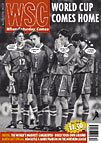 Nick Wyke looks at the efforts being made to promote women's football in Italy in the face of media indifference
Nick Wyke looks at the efforts being made to promote women's football in Italy in the face of media indifference
Italy’s Serie A is, arguably, the most prestigious and rigorous league in world football. As a result, Italian women have a reputation to live up to. Their cause has not been helped by a media that shirks the women’s on-pitch efforts in preference for sideline gossip.
In the spacious pages of the sports dailies, like the Gazzetta and Corriere Dello Sport, women’s match reports, if reported at all, are relegated to inconspicuous backpage paragraphs. The fact that so many male referees are reportedly clamouring to supervise female matches in Italy has less to do with an interest in the women’s game and more to do with an interest in women. Even the Gazzetta’s London correspondent, Giancarlo Galavatti, thought that calcio femminile was “something that you eat”.
Several months before Maradona’s infamous cocaine collapse, the goalkeeper of the Italian women’s national team, Eva Russo, was fired on a charge of coke-snorting. For the press it was as if women were only able to emulate the vices of the great male role models.
In November 1994 women’s football was brought into the limelight again. Not for their plucky performance in the World Cup qualifying group, but because the president of a women’s amateur team near Brescia disbanded the club for having “too many gay women”. The players were outraged at his outspoken bigotry and Marina Sbardella, president of the women’s football league, lodged a formal complaint. The team promptly went on a strike and proceeded to sue Signor President for slander.
The incident stirred up considerable sympathy and elicited some serious comment in the national media on the uphill struggle for women players in Italy. The Brescia Belles won their case and re-united, notching up a victory for the women’s game against provincialism.
At a national level, Italy’s female Azzuri were the first European team to turn professional in the 1970s, and leading their first renaissance is the highly-esteemed veteran striker and TV hostess, Carolina Morace. (How long is it before women join messrs Lynham and Lineker on terrestrial GB TV?)
Morace is a phenomenon in Italy, a rare female football icon who attracts attention to the women’s game. She played her first Serie A game aged thirteen and a half, has netted nearly 1,000 goals and is a silverware magnet having collected ten championships with four different clubs. Arsenal’s coach Rik Akers reckoned that in the last England v Italy European qualifying clash she “won the game on her own”. Approaching her mid-30s, the multi-talented Carolina is the Vecchia Signora of women’s football. Post-football she intends to put her law degree to good use. Perhaps defending women’s football teams . . .
The Croydon player, Kerry Davies, who spent four seasons in Italy, considers Morace to be “the best women’s player I’ve ever seen”. In England there is not a public figurehead to compare with Morace. Davies believes that “women’s football in Italy is better funded and organized” than back home, with more emphasis on tactical training and nurturing teenage hopefuls.
In the nineties, inspired by Italia ’90 and USA ’94, the gap between senior professionals like Morace and up and coming talent in Italy has narrowed. Although volleyball remains by far the most popular sport amongst young Italian women, a thriving calcetto culture – outdoor 5-, 6-, 7- and 8-a-side matches played on artificial mini-pitches – has boomed, facilitating the development of players and talent spotting.
There has also been a healthy increase in female attendances at Italian football. Clubs such as Parma offer special incentives to attract women to home games, and at Serie B Pescara one in six of its 3,000 official supporters are female.
The last report by the Italian women’s FA stated that “media interest and also sponsorship would boost the development of the sport”. Perhaps the Paparazzi di Pallone (the football press) might acknowledge that women’s football has managed to develop its own identity and culture away from the men’s game; and respect, even relish, the fact that in Italy today there are two Serie A’s.
From WSC 121 March 1997. What was happening this month